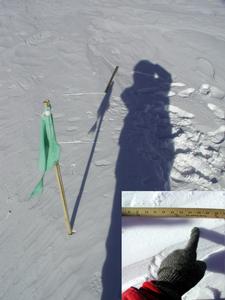7 December, 2001
The day started with a meeting between all of the member of the SPASE team: Bai, Serap, Jerry, and myself. We discussed what had been accomplished so far and the results of the light test. After inspecting the detector, we decided to go ahead and have the water delivered on Saturday.
The 800 gallons of water that we will use for our detector will be drawn from the Rosewell drinking well. The well is a 300 meter hole drilled in the ice where liquid water is stored. The water does not freeze immediately because ice is an excellent insulator. Once the water is added to the tank, we will have to turn on our heating unit to prevent it from freezing too quickly.
Since a few days are available before the water is delivered, we began working on the detector that Bai had installed the previous season...his muon telescope. The purpose of the research with the muon telescope is to determine the flux of muons. The muons that the telescope detects are mostly generated from the sun.
The sun obtains its primary energy from the fusion of hydrogen atoms into helium atoms. This process generates a tremendous amount of energy, which expells a large amount of matter from the sun's surface and atmosphere. The continuous flow of parcticles from the sun is known as the solar wind. It is mostly electrons and atomic nuclei. Some of these parcticles hit the Earth's atmosphere, striking the atoms of our atmosphere. These collisions set off a chain reaction of atoms and subatomic parcticles showering down onto the Earth's surface. The events are known as cosmic air showers. A good way to image it is as a game of pool. The cue ball strikes the other balls setting them in motion. However, unlike the flat surface of the pole table, the cosmic parcticles that initiate these showers are effected by gravity, falling downward.
As the parcticles generated in these showers cascade toward the Earth's surface, muons are created as the result of atomic collisions. By determining the path of the muons entering the muon telescope, the path of the instigating cosmic parcticles (cue ball) can be calculated.
Bai is not only interested in learning the path of these parcticles, but also how many pass through the tank in a given time. This information will be useful for the AMANDA researchers in calibrating their instrument, for the flux of muons is not always the same. The sun operates on an eleven year solar cycle. The solar maximum, or time when the sun is most active, has just past. We expect the flux of muons to now decrease as the sun heads towards solar minimum. AMANDA needs to know this information so they can expect how many muons pass through their detector each year.
Biological Data
Saturated Oxygen: 95%
Pulse Rate: 73
Weather Data
Temperature: -31.7 F
Windchill: -82.1 F

Solar Shadow Experiment 12/07/2001

Gear that I will be using for tomorrow's special excursion.
Contact the TEA in the field at
.
If you cannot connect through your browser, copy the
TEA's e-mail address in the "To:" line of
your favorite e-mail package.
|
